Homemade lacto-fermented pickles couldn’t be easier or more delicious. If you have time to slice them up and add them to salt water, you have time to make this recipe. This is seriously the simplest recipe ever and makes the best tasting, mildly sour, probiotic pickles.
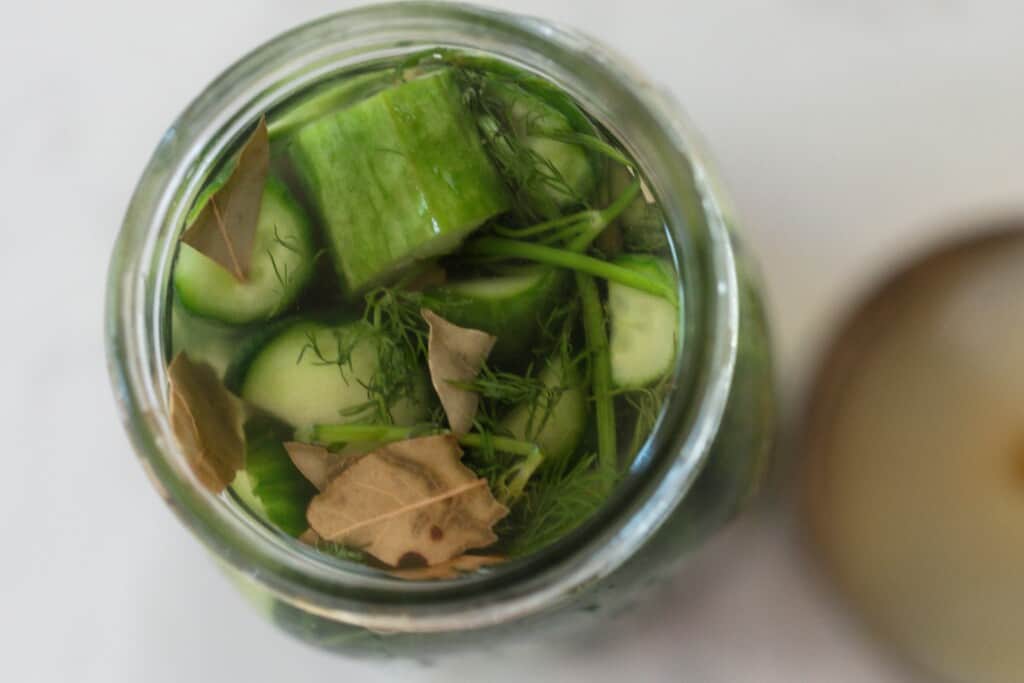
Table of Contents
- Homemade Fermented Pickles Are Super Simple To Make
- We Love Fermented Foods!
- A Few Notes And Tips:
- Fermented Pickles Ingredients:
- What Type Of Pickles Should Be Used For Fermenting:
- How To Make Lacto-Fermented Pickles:
- FAQ:
- How To Make Crunchy Pickles
- Try More Delicious Fermented Recipes:
- Homemade Fermented Pickles Recipe
This easy fermented pickle recipe honestly seems like a pretty sorry excuse for a blog post.
I mean, really. How could anything with so few steps and ingredients ever be considered revolutionary enough to be worthy of your time, dear reader?
Well, if your garden overfloweth with homegrown cucumbers and/or you want to start incorporating more fermented vegetables into your diet, I think you will love this super simple recipe.
Honestly, it has been a game changer for me with my last few cucumber harvests.
I remember last year, we ate more vinegar cucumbers, cucumber cream cheese sandwiches on sourdough, and plain old salted cucumbers than we could stand.
Soon, I started making cucumber mint infused water by the gallon. But after all that, what else was a girl to do?
I mean, making fermented cucumber pickles is hard, right? Surely no mom of seven has time for that!
Now, I’m thinking, “Why the heck didn’t I just make more lacto-fermented pickles?!”
Read more on the benefits of fermented vegetables HERE.
Spoiler alert: there are only three ingredients in this recipe: cucumbers, water, and salt.
That’s it.
You may be thinking that fermenting vegetables is intimidating and scary.
Isn’t there some recipe that doesn’t require fermenting?
Yes, there are. But, guess what? They are actually HARDER than this simple recipe, and nowhere near as beneficial for the gut!
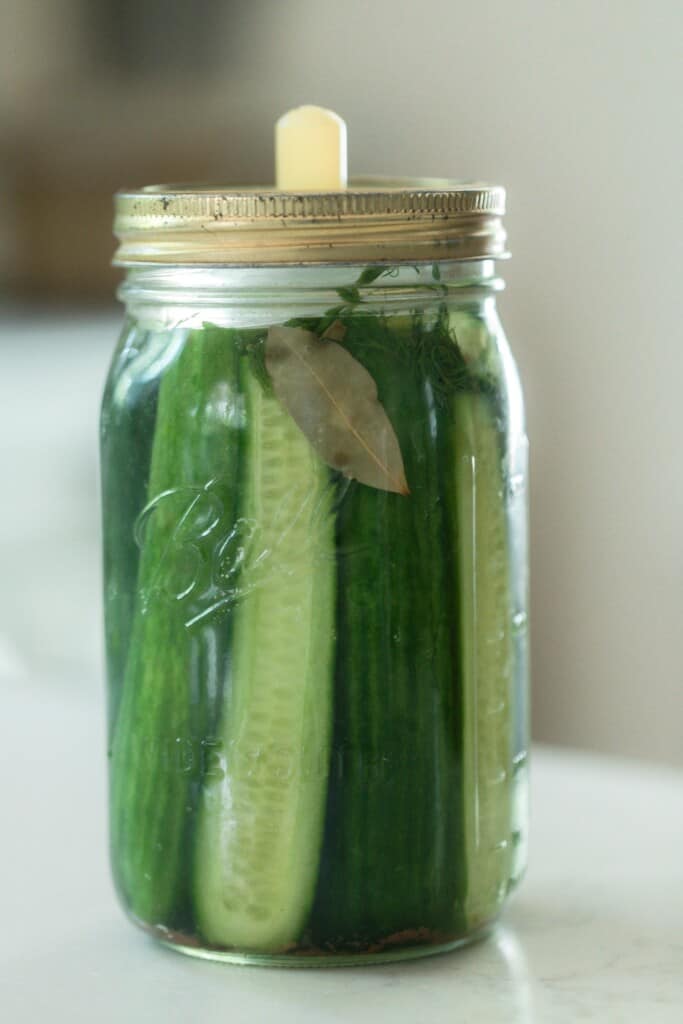
Homemade Fermented Pickles Are Super Simple To Make
Before I started fermenting vegetables myself, I was overwhelmed by all the options that I saw all over Pinterest. “How to Ferment Vegetables with Whey”, “Best Starter for Homemade Fermented Vegetables”, “Why Lacto Fermentation is the Best”, “Best Air Locks for Home Fermenting”…… Whaaaaaa?
For a few years I decided that fermenting was too difficult. I was going to go crawl in a hole and avoid any article that resembled a fermenting tutorial.
Friends, I’ve been there. If you’re where I was, let me gently back you off that ledge and give a quick science lesson.
Salt is a special little mineral that prevents the growth of harmful bacteria.
When ferments are submerged in a salt brine, the good bacteria present on the fresh vegetables, namely Lactobacillus, can proliferate and grow uninhibited by bad bacteria. It also helps turn sugars into lactic acid.
So, my point is… all you need for vegetable fermentation is salt, veggies, and water. The process really couldn’t be any easier and less intimidating.
Read about how to make homemade sauerkraut here and homemade kimchi here.
Think of fermentation as growing your own probiotics full of health benefits.
Now, on to the easy fermented pickle recipe.
We Love Fermented Foods!
We love these sour pickles, and you can bet I will be making many, many more this summer, as we are up to our ears in garden cucumbers.
For my next batch, I am going to just throw the freshly sliced cucumbers in the brine from the previous batch. Since it is already teeming with the beneficial bacteria, it will serve as a jump start for the process in the next batch.
Fermented vegetables, like these fermented pickles, can last six months or more in the refrigerator, IF you can go that long without eating them all up.
This post contains affiliate links, which means I make a small commission at no extra cost to you. See my full disclosure here.
A Few Notes And Tips:
- It is normal for the saltwater brine to get cloudy. This is a natural byproduct of vegetable fermentation and does not mean mold. For more fermented vegetable troubleshooting questions, check out THIS article.
- Take one out and try it. If it is sour enough for you, put the lid on tightly, and throw the jar in the fridge. If you would like them to get a little more sour, leave them out at room temperature to ferment a little longer.
- After you make your first batch, you can use some of the brine to make your next batch of probiotic pickles. It already contains a plethora of good bacteria, so you’ll be giving your next batch a head start.
- I like to use pink Himalayan salt. You could use sea salt or Celtic salt, but don’t use iodized table salt.
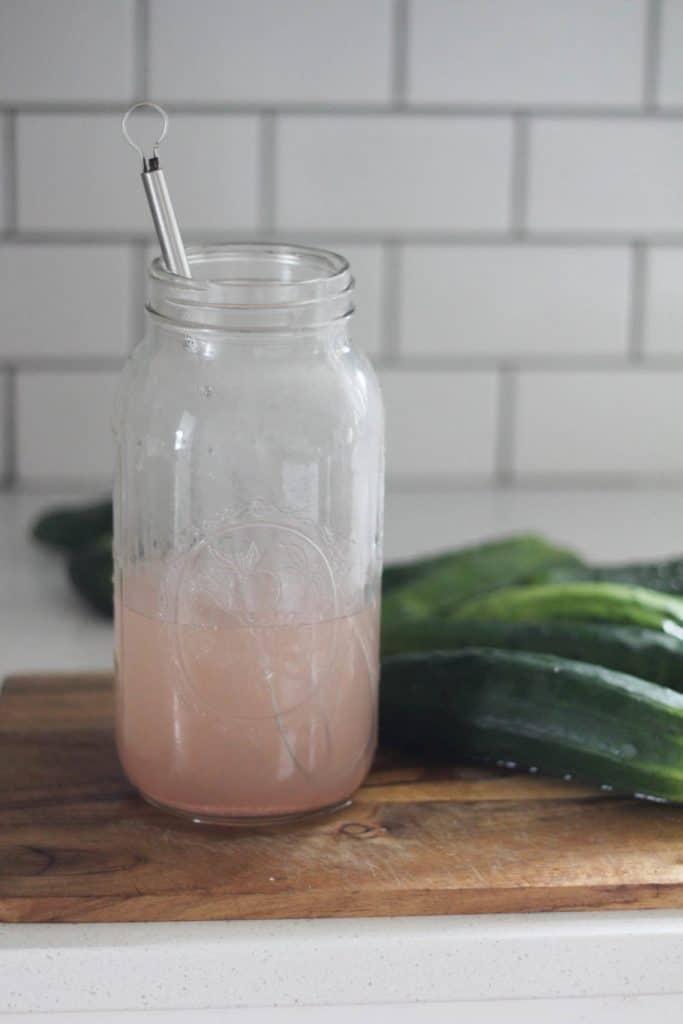
Fermented Pickles Ingredients:
Salt – Himalayan salt and sea salt are your best options. You don’t want to use iodized salt. Kosher salt may also be a good option, but it may contain anti-caking agents which you want to avoid.
Water – Preferably filtered water. City water can contain chlorine which can inhibit the good bacteria growth.
Cucumbers – Pickling varieties of cucumbers are the best choice because they contain less water and tend to stay crunchier than other types. You can use other types of cucumbers, but they may not have a great texture after fermentation.
What Type Of Pickles Should Be Used For Fermenting:
Pickling cucumbers work best due to their lower water concentration, but any cucumbers will work.
- Boston pickling cucumbers are my favorite.
- Kirby
- Bush pickle
- National pickling cucumber
- Calypso
- northern pickling
- Picklebush
- Carolina, just to name a few.
- Kirby cucumbers
Choose small to medium sized cucumbers. Small cucumbers are the best.
Salt In Fermentation:
I like to use Pink Himalayan Salt. You could use sea salt or Celtic salt, but don’t use iodized table salt.
Salt creates an environment that prevents bad bacteria from growing and allows the good bacteria, Lactobacillus, to thrive. It also helps keep the vegetables crunchy and slows down the fermentation process which helps add a lot of flavor.
Tools you may need:
Half gallon glass jar. Quart jar will also work, I just like to make big batches at a time.
Berkey Water Filter (optional)
Knife
Cutting board
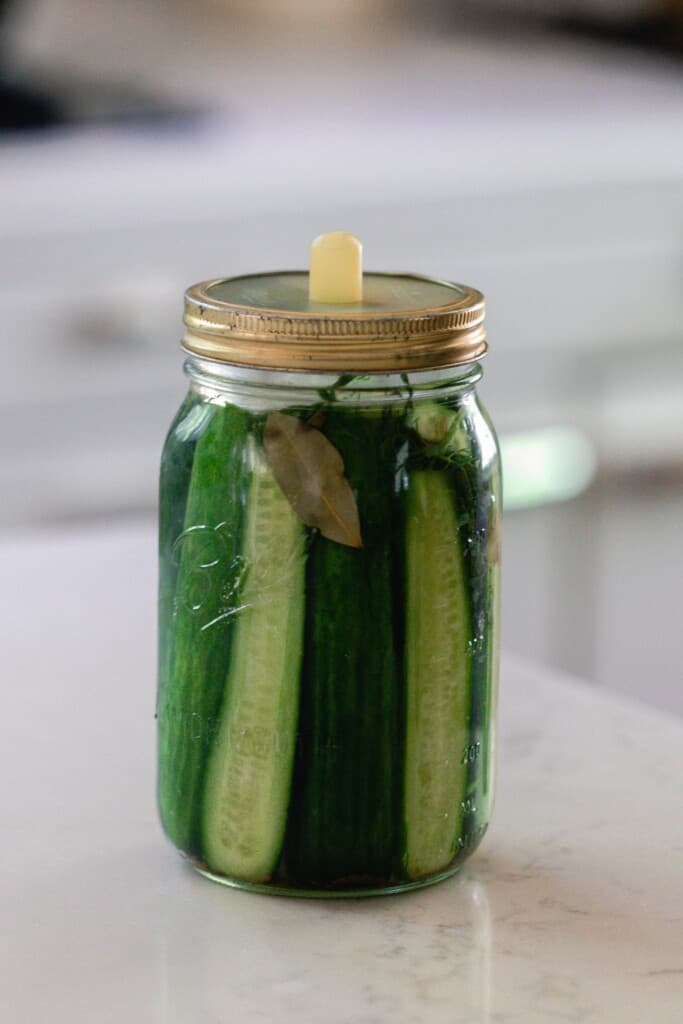
How To Make Lacto-Fermented Pickles:
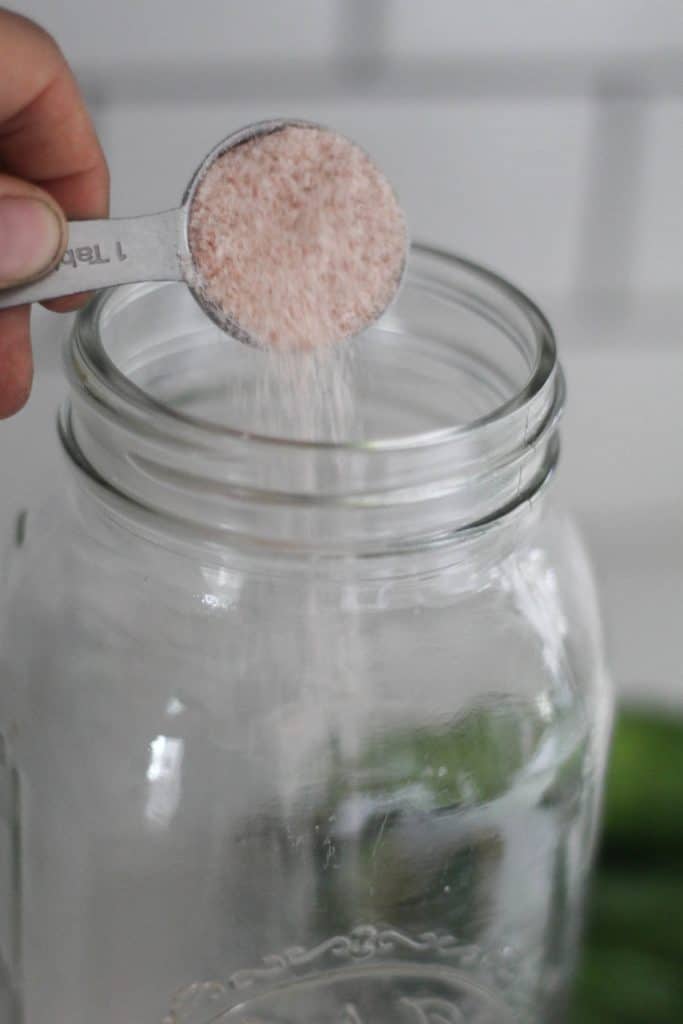
Making the brine
Add four tablespoons of salt to a half gallon size mason jar.
Next, bring a couple cups of filtered water to a simmer. This is going to be used to dissolve the salt.
Add the hot water to the salt and stir to combine. Fill the jar the rest of the way with filtered water and set aside to cool.
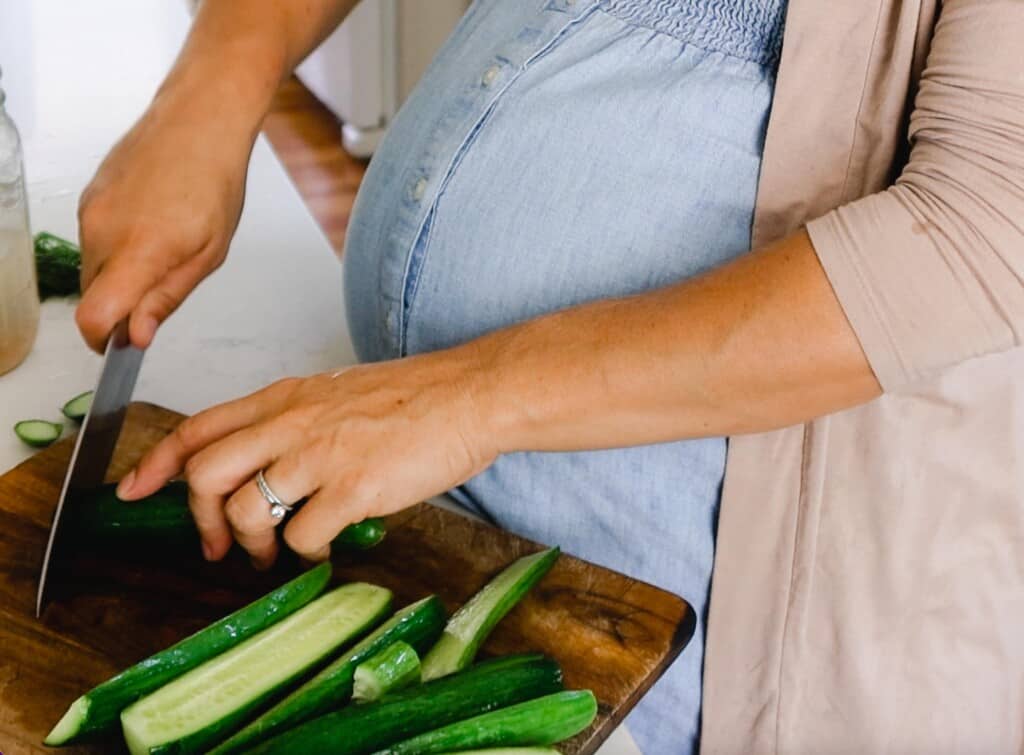
Slice Cucumbers
Add sliced cucumbers to another half gallon mason jar. I like using small, firm pickling cucumbers.
I like to slice them in approximately half-inch rounds. If they are too thin, they can get soggy, and who likes soggy pickles?
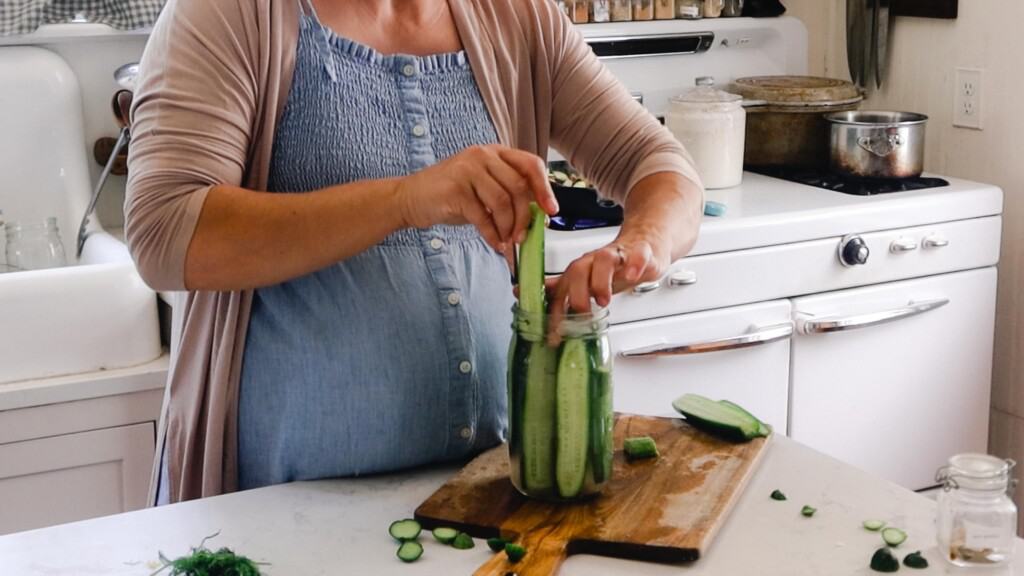
Optional Add-Ins
Now, this is the part where you could get creative and add parsley, dill, cloves of garlic, or whole black peppercorns.
Emphasis on the COULD.
As in, you don’t have to.
My kiddos love these sour brine pickles, and I just don’t want to mess a good thing up. I’m afraid they would turn their noses up at garlic parsley pickles with peppercorns, and we wouldn’t want that.
If you want to make dill pickles, add about two heads of fresh dill per half gallon or some dill seeds.
I added some parsley for the photo, but like I said, I just pulled that little sprig right back out and got on with my plain Jane pickle makin’.
After the salt water brine has cooled, add it to the jar of cucumbers, leaving at least 2 inches of headspace at the top.
Add a Weight
Add a fermentation weight to keep the sliced cucumbers under the brine. You want to make sure the cucumbers stay under the brine to prevent mold from developing.
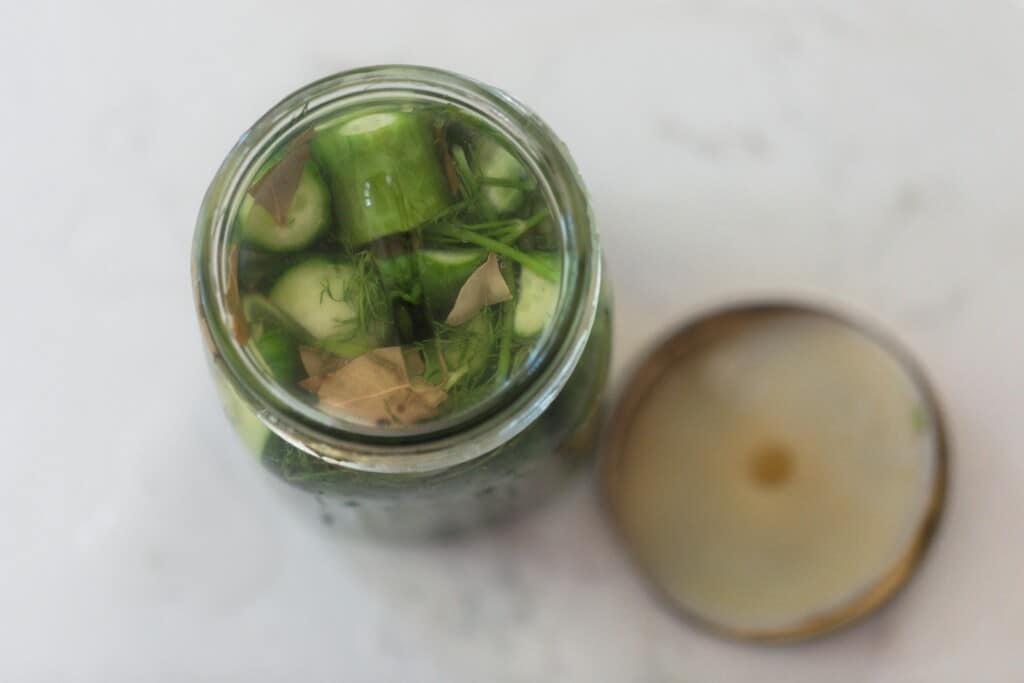
Screw on the Lid
After the cucumbers are weighed down in the salty brine, cover the jar with a fermentation lid and place the jar ring on loosely.
Fermenting does create some natural gases that need to be released, so if you are not using a fermentation lid, don’t screw the lid on too tightly. However, do keep it covered so flies and varmints don’t decide to feast on your pickles.
You can also use these Pickle It fermenting lids, but you definitely don’t have to. The purpose of the lids is to allow gases to escape, while letting nothing else in.
I use them all the time, but they were already in use in other ferments when I was making this tutorial. You can pretty much accomplish the same thing with a loose lid.
Place in a dark place out of direct sunlight.
Allow to ferment until desired taste is reached. This can be 3-5 days if they are in a warm place, or longer depending on the environment.
FAQ:
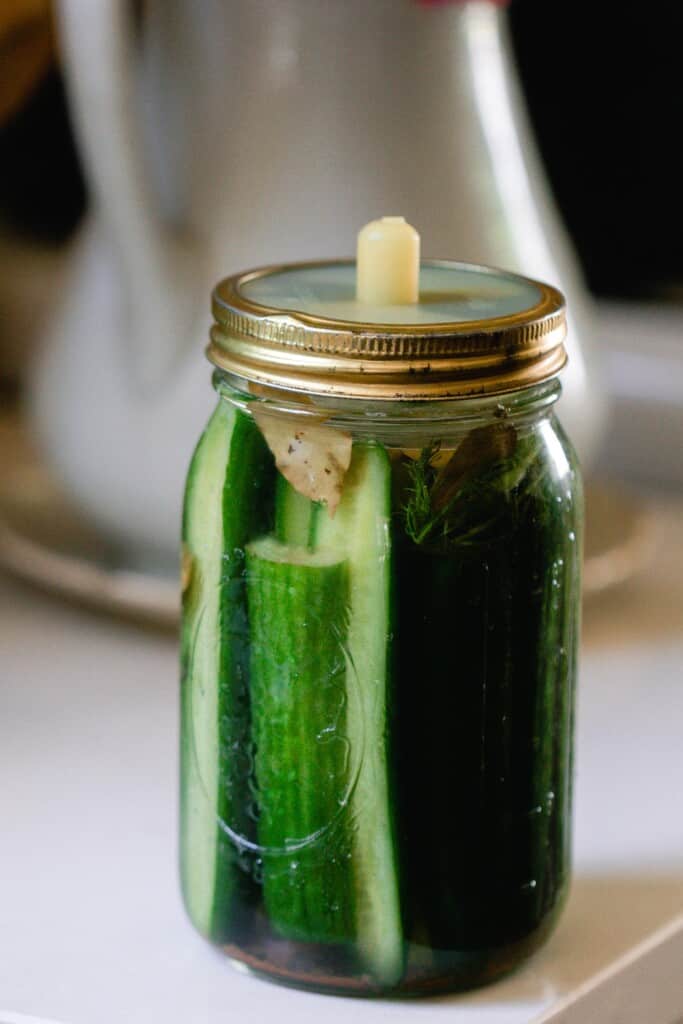
How long does it take to ferment pickles?
It usually takes 5-7 days for the fermentation process. After five (or so) days, they will usually taste perfectly pickle-ish.
What is the salt-to-water ratio needed for fermentation?
The salt-to-water ratio is commonly between 2-5%. Somewhat depends on taste. Most recipes will call for about 2 tablespoons of salt per quart of water.
Can fermented pickles make you sick?
There is a low risk of pickles making you sick. Always make sure your tools and jars are very clean. Always check for signs of mold and toss if there is mold.
How do you keep homemade pickles crunchy?
If you want your pickles to stay really crunchy you can add a grape leaf to them. This is totally optional, but the tannins in the grape leaf help keep that crunch.
What is brine pickling?
Brine pickling is the process of preserving with salt water.
What is pickle brine made of?
Water and salt. It is that simple. You can also add other herbs and spices if desired.
Is brine the same as vinegar?
No, they are different. Brine refers to a salt-water mixture, while vinegar is an acidic liquid made from the fermentation of alcohol.
Are all pickles lacto-fermented?
No. Most store bought pickles are not lacto-fermented unless stated on the label. Due to the canning process, all the good bacteria produced during the fermenting process would be killed.
Is lacto-fermentation the same as pickling?
No, lacto-fermentation has the presence of good bacteria that ferments and helps preserve the vegetables. Whereas, pickling is the process of soaking vegetables in a mixture of vinegar, salt, and water which gives it a sour taste.
What do lacto-fermented pickles taste like?
They have a salty, tangy, and slightly acidic flavor.
Can I add other spices to fermented pickles?
Yes. Add garlic cloves, dill, mustard seeds, red pepper flakes (for some heat), bay leaves, etc.
What vegetables can you lacto-ferment?
There are lots of vegetables you can lacto-ferment like: beets, cabbage, carrots, cauliflower, cucumbers, garlic, green beans, kohlrabi, peppers, radishes, snap beans, tomatoes (we love making fermented salsa), turnips, and zucchini. I created a whole guide on how to lacto-ferment vegetables here.
How To Make Crunchy Pickles
Typically, I find that my pickles stay pretty crunchy, but if you are struggling with mushy pickles, you can add something that has tannins in it like oat leaves or grape leaves. Adding tannins is an easy way to ensure you get crunchy pickles.
Try More Delicious Fermented Recipes:
- Homemade Fermented Ketchup
- Lacto-Fermented Garlic
- How To Make Fermented Fruit
- Lacto Fermented Salsa Recipe
- Fermented Carrots Recipe
- How To Make Fermented Jalapeños
- Fermented Balsamic Blueberry Vinaigrette
If you try this recipe and love it, I would love if you could come back and give it 5 stars! Tag me on Instagram @farmhouseonboone
Homemade Fermented Pickles
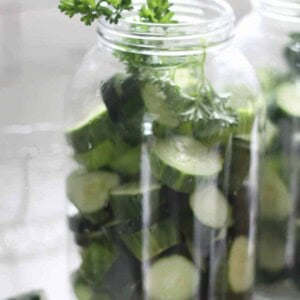
Video
Ingredients
- 4 medium cucumbers
- 1/2 gallon filtered water
- 4 tablespoons sea salt, Pink Himalayan Salt, sea salt or Celtic salt*
Instructions
- Add four tablespoons of salt to a half gallon size mason jar.
- Next, bring a couple cups of filtered water to a simmer.
- Add the hot water to the salt and stir to combine.
- Fill the jar the rest of the way with filtered water and set aside to cool.
- Add thick sliced cucumbers to another half gallon mason jar.
- Add in optional herbs such as fresh dill, garlic, parsley, or peppercorns. If you want to make dill pickles, add about two heads of fresh dill per half gallon.
- After the salt water brine has cooled, add it to the jar of cucumbers, leaving at least 2 inches of headspace at the top.
- Add a weight to keep the sliced cucumbers under the brine.
- After the cucumbers are weighted down in the salty brine, put the jar lid on loosely. Fermenting does create some natural gases that need to be released, so don’t screw the lid on too tightly, but do keep it covered so flies and varmints don’t decide to feast on your pickles.
- After five (or so) days, they will taste perfectly pickle-ish.
Notes
- *Don’t use iodized table salt.
- It is normal for the brine to get cloudy. This is a natural byproduct of vegetable fermentation and does not mean mold.
- Take one out and try it. If it is sour enough for you, put the lid on tightly, and throw the jar in the fridge. If you would like them to get a little more sour, leave them out at room temperature to ferment a little longer.
- After you make your first batch, you can use some of the brine to make your next batch. It already contains a plethora of good bacteria, so you’ll be giving your next batch pf probiotic pickles a head start.
Nutrition
Nutrition information is automatically calculated, so should only be used as an approximation.
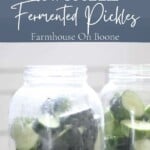
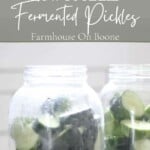
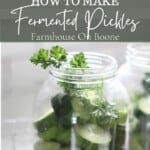
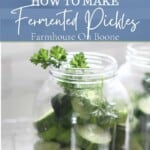
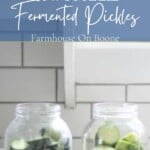
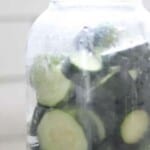
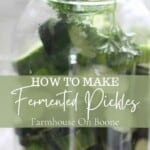
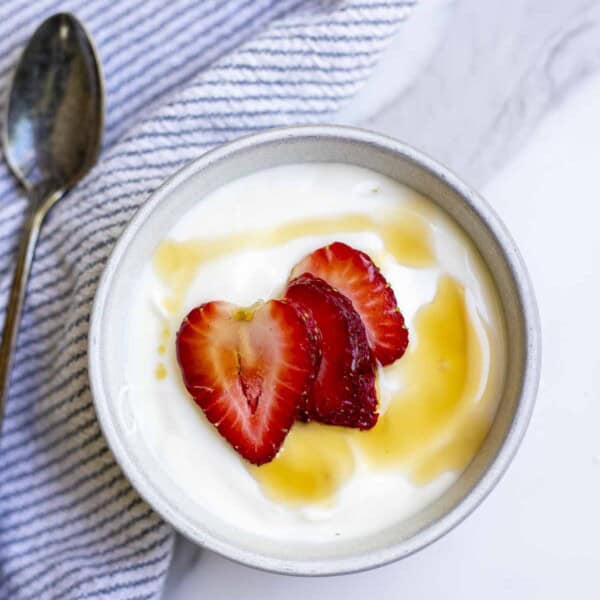
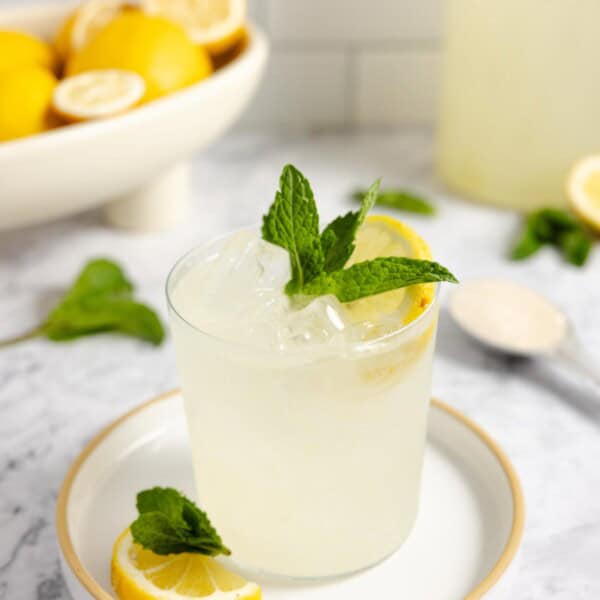
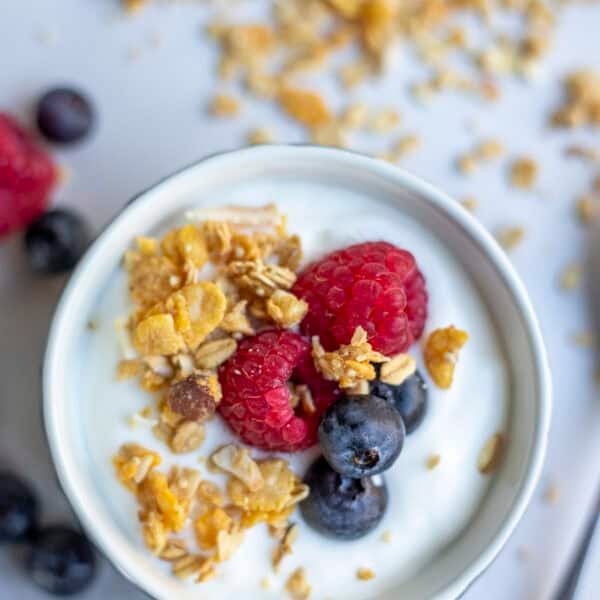
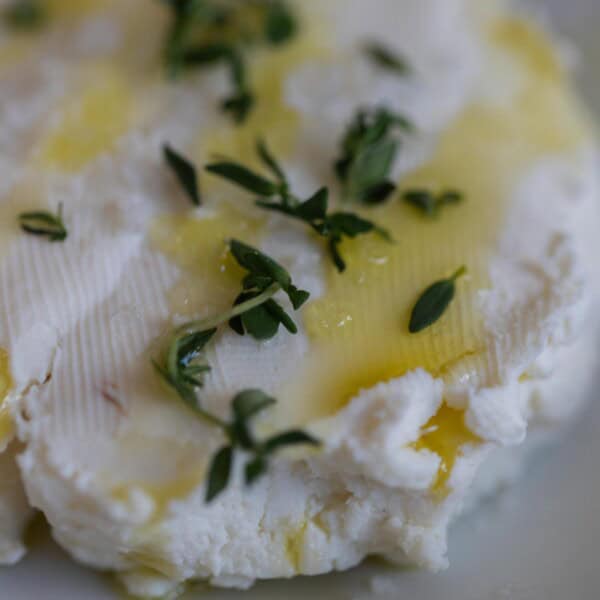






These are delicious!!😍 I’d love to make more to store! Is there any way to make these shelf stable for longer than 6 months? (Pressure canning or water bath canning?) or would the jars explode because of the gasses involved or would the heat just kill all the bacteria??
Thanks for all you do!
-Autum
You are able to can them, but the heat causes the good bacteria to die. It’s not as beneficial. You can keep them in your fridge for quite a long time though!
I’ve been making very sour garlic dill fermented pickles for years (and my Mom before me) and I use a couple bay leaves to keep crunchy. My last batch I increased the number of bay leaves because
More is better, right? And my pickles came out completely destroyed, total mush! Can’t even side them. The taste is the same… so you know why this happened and are they safe to eat? I have had a few, lol…Thanks
Hmm. That’s interesting. I wouldn’t think it would be because of the bay leaves. Did you use really hot water? Sometimes that can cause them to be mushy.
Can I add sugar to make these a sweet pickle?
I would add sugar after the first fermentation is finished. Sometimes sugar can interfere with the first fermentation process! So after your pickles are ready, you could add sugar to them for sweet pickles.
Hi!
I followed the directions exactly and bought the fermentation weight and tops and the top of the water and caps had mold on them. I left them on the counter for 5 days as directed. What could be the reason it molded?
Something traveled up above your weight! Make sure to get all the dill poked down below the weight. Anything that touches air will mold.
I really like lacto fermented pickles. I don’t measure salt by volume, but by weight as it can vary quite a bit depending on what type you are using (flake vs grain). Also I calculate salt by taking the weight of the veg and water in the jar, subtracting the weight of the jar, and multiplying by 2%, The problem with using a brine is that the strength of your solution in each jar varies greatly depending on how much veg you put in your jar. Calculating salt as a percentage of the weight of the contents of the jar means no matter how much veg or water is in the jar, the salt content will not vary jar to jar and since most vegetables, like cucumbers are mostly water, this is a good way to ensure a constant salt content. It is one extra step, but still way easier than vinager pickles.
How long will these stay good in the fridge after you have fermented them for 3-5 days at room temperature?
6 months or so!
Cucumbers .The top layer under the grape leaves were very soft. On down the slices were firmer but I hesitated because the top ones were mushy . I let them ferment on the countertop for probably a week. Had air lock on.
How much dill seed should I use since I don’t have fresh dill?
I’d use 1-2 tsp!
Mine tasted super super salty! What did I do wrong??
Did you fill your jar with too many pickles? Sometimes that can cause your mixture to be too concentrated and could lead to a more salty taste.
Can I make in a crock on the counter?
Sure can!
If there’s mold under the jar lid above the weight and food so not touching anything, what do I do? It looks like the liquid and spices above the weight solidified and molded. Can I still eat the Pickles? They were all fully submerged.
I would be fine to scoop off the liquid containing the mold, since it is not touching any of the pickles. This is my personal opinion based on my own experiences. Please use your own judgement for your specific circumstance when deciding if any food is safe to consume.